Last updated: June 28, 2023
Article
New Philadelphia: A Multiracial Town on the Illinois Frontier (Teaching with Historic Places)
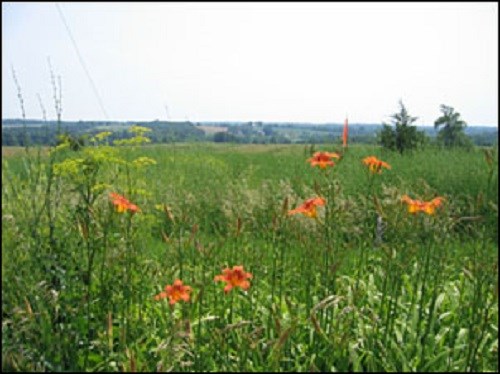
(Pat Likes, photographer)
New Philadelphia looked like a typical west-central Illinois pioneer town to travelers cresting the hill overlooking the place in the mid-1800s. Imagine villagers filling baskets with a bounty of apples, corn, and wheat, while chickens clucked and pigs rooted in nearby pens. Picture farmers hitching mules and oxen to carts filled with vegetables, fruit, and grain to sell at markets. Listen for loud clanging from the blacksmith's shop as hammers shaped hot metal into shoes for mules and horses. As in other frontier towns, smoke from cooking fires swirled from the dwellings that dotted small plots of land.
But New Philadelphia was not a typical pioneer town. It was the first town platted and registered by an African American before the American Civil War. A formerly enslaved man called "Free Frank" McWorter founded New Philadelphia in 1836 as a money-making venture to buy his family out of slavery. Census records and other historical documents tell us that New Philadelphia was a place where black and white villagers lived side by side, but we know that the town's dead lie buried in cemeteries separated by color.
By 1885, many villagers had moved away in search of jobs and better economic opportunities. Plows buried any material remains left behind, and grazing livestock and crops covered most of the site. By the 1940s, nothing of the town remained above ground. However, the town's descendants and neighboring communities did not forget New Philadelphia. Descendents continued to live in the area until the 1950s. Grace Matteson wrote "Free Frank" McWorter and the "Ghost Town" of New Philadelphia, Pike County, Illinois. Later, Lorraine Burdick remembered the town in New Philadelphia: Where I Lived. McWorter family descendants were members of the Negro History Movement led by Carter G. Woodson, and through their activities the story of Free Frank was kept alive. Helen McWorter Simpson, great granddaughter of Free Frank McWorter, wrote Makers of History. Juliet E. K. Walker memorialized her great great grandfather in Free Frank: A Black Pioneer on the Antebellum Frontier. Archeologists and historians pieced together historic documents, recollections of the town's descendants, and artifacts to tell the story of New Philadelphia and the lifeways of its diverse townsfolk.
About This Lesson
This lesson is based on the National Register of Historic Places nomination for the New Philadelphia Town Site, Illinois. Other materials include Juliet E. K. Walker's book Free Frank: A Black Pioneer on the Antebellum Frontier and data from New Philadelphia documentation and research. It was written by Charlotte King, National Council for Preservation Education intern with the National Park Service Archeology program. Paul Shackel of the University of Maryland, Christopher Fennell of the University of Illinois at Urbana-Champaign, and Terrance Martin of the Illinois State Museum helped with photographs and text editing. Barbara Little, of the NPS Archeology Program, provided editorial assistance. William Walters, professor emeritus from Illinois State University, and Ronald Collins of the Illinois State Archives provided background materials. The lesson was also edited by Ms. Sandra McWorter, Dr. Abdul Alkalimat (Gerald McWorter), members of the New Philadelphia Association, and the staff of Teaching with Historic Places. This lesson is one in a series that brings the important stories of historic places into classrooms across the country.
Where it fits into the curriculum
Topics: This lesson can be used in American history courses in units on the Antebellum and Reconstruction periods or on westward expansion. It could also be used in units on African-American culture or historical archeology.
Time period: mid 19th century
United States History Standards for Grades 5-12
New Philadelphia: A Multiracial Town on the Illinois Frontier relates to the following National Standards for History:
Era 4: Expansion and Reform (1801-1861)
-
Standard 2D- The student understands the rapid growth of "the peculiar institution" after 1800 and the varied experiences of African Americans under slavery.
-
Standard 2E- The student understands the settlement of the West.
-
Standard 3B- The student understands how the debates over slavery influenced politics and sectionalism.
-
Standard 4A- The student understands the abolitionist movement.Era 5: Civil War and Reconstruction (1850-1877)
-
Standard 3C- The student understands the successes and failures of Reconstruction in the South, North, and West.
Curriculum Standards for Social Studies
(National Council for the Social Studies)
New Philadelphia: A Multiracial Town on the Illinois Frontier relates to the following Social Studies Standards:
Theme I: Culture
-
Standard E - The student articulates the implications of cultural diversity, as well as cohesion, within and across groups.
Theme II: Time, Continuity and Change -
Standard B - The student identifies and uses key concepts such as chronology, causality, change, conflict, and complexity to explain, analyze, and show connections among patterns of historical change and continuity.
-
Standard C - The student identifies and describes selected historical periods and patterns of change within and across cultures, such as the rise of civilizations, the development of transportation systems, the growth and breakdown of colonial systems, and others.
-
Standard D - The student identifies and uses processes important to reconstructing and reinterpreting the past, such as using a variety of sources, providing, validating, and weighing evidence for claims, checking credibility of sources, and searching for causality.
-
Standard E - The student develops critical sensitivities such as empathy and skepticism regarding attitudes, values, and behaviors of people in different historical contexts.
Theme III: People, Places and Environments
-
Standard A - The student elaborates mental maps of locales, regions, and the world that demonstrate understanding of relative location, direction, size, and shape.
-
Standard B - The student creates, interprets, uses, and distinguishes various representations of the earth, such as maps, globes, and photographs.
-
Standard C - The student uses appropriate resources, data sources, and geographic tools such as aerial photographs, satellite images, geographic information systems (GIS), map projections, and cartography to generate, manipulate, and interprets information such as atlases, data bases, grid systems, charts, graphs, and maps.
-
Standard H - The student examines, interprets, and analyzes physical and cultural patterns and their interactions, such as land uses, settlement patterns, cultural transmission of customs and ideas, and ecosystem changes.
-
Standard I - The student describes ways that historical events have been influenced by, and have influenced physical and human geographic factors in local, regional, national, and global settings.
-
Standard K - The student proposes, compares, and evaluates alternative uses of land and resources in communities, regions, nations, and the world.
Theme VIII: Science, Technology and Society
-
Standard A - The student examines and describes the influence of culture on scientific and technological choices and advancement, such as in transportation, medicine, and warfare.
-
Standard C - The student analyzes and explains ideas and governmental mechanisms to meet wants and needs of citizens, regulate territory, manage conflict, and establish order and security.
Objectives for students
1) To explain how New Philadelphia developed and why it did not survive as a town
2) To describe the role of African Americans in securing their own freedom
3) To evaluate the effects of racism on New Philadelphia and other communities
4) To describe the ways in which archeology can help interpret the past
5) To identify and describe legal restrictions on African Americans in their own communities
Materials for students
The materials listed below either can be used directly on the computer or can be printed out, photocopied, and distributed to students. The maps and images appear twice: in a small version with associated questions and alone in a larger version.
1) One map showing New Philadelphia's location;
2) One drawing showing the layout of New Philadelphia in 1836;
3) Three readings about New Philadelphia, its founder, and the 2004-2006 archeological investigations of the site;
4) An excerpt from the 1850 manuscript census for Illinois;
5) Five photographs of the New Philadelphia site and artifacts and features recovered during the archeological excavations.
Visiting the site
New Philadelphia is located in Pike County in Western Illinois, about 30 miles southeast of Quincy. For more information, visit the New Philadelphia Association website.
Getting Started
Inquiry Question
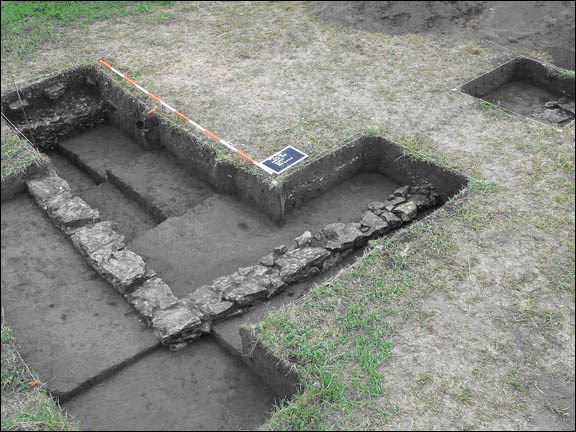
What do you think you are looking at in this image?
Setting the Stage
Seventeenth-century European explorers and settlers required a force of laborers to tame and cultivate what they called the New World. Indentured servants provided some of the necessary workers, but by the mid-17th century, a slave trade set up in Africa was forcibly bringing men, women, and children to clear land, plant, tend, and harvest crops, and build towns. By the late 18th century, many people thought that the practice of slavery was incompatible with the ideals of equality and freedom on which the newly formed United States of America was based. By the time the United States Congress established the Territory of Illinois in1809, slavery was a contentious issue nationwide. Attempts to expand slavery clashed with a growing conviction that the practice should be abolished, eventually dividing the nation and erupting into the Civil War.
At first, threats to settlers from Native Americans living in the region and dependence on goods shipped from distant markets limited the growth of the Illinois Territory. That territory originally included today's states of Illinois, Wisconsin, northern Minnesota, and the western portion of Michigan's Upper Peninsula. Many early residents moved into this area from southern states. To promote settlement of the Illinois Territory, the United States government set aside 3.5 million acres of land between the lower Illinois and Mississippi rivers called Military Tract Land in 1817. The land was parceled into 160 acre tracts and awarded to veterans for their military service; private citizens also purchased affordably priced parcels of Military Tract Land.
Illinois joined the United States in 1818 as a free state that prohibited slavery. Slavery was permitted in Missouri and Kentucky, across the rivers on the new state's southern and western borders. Exceptions to the ban on slavery in Illinois were made, however, in some instances. These included the enslaved labor force used to extract salt from saltwater springs in the southern Illinois American Bottoms region and those enslaved individuals owned by French citizens before the state was created.
Settlements on the new frontier flourished after the last American Indian tribes in the region were removed to reservations in 1832. Canal and river transportation also created new markets and economic opportunities in the region. In 1819, alarmed by competition for resources from the influx of free African Americans, Illinois became one of many states to enact stringent Black Codes that controlled and restricted virtually every aspect of African American life. Such was the state of affairs in Illinois when a former slave named Free Frank founded the town of New Philadelphia in 1836.
Locating the Site
Map 1: Illinois, showing the location of New Philadelphia
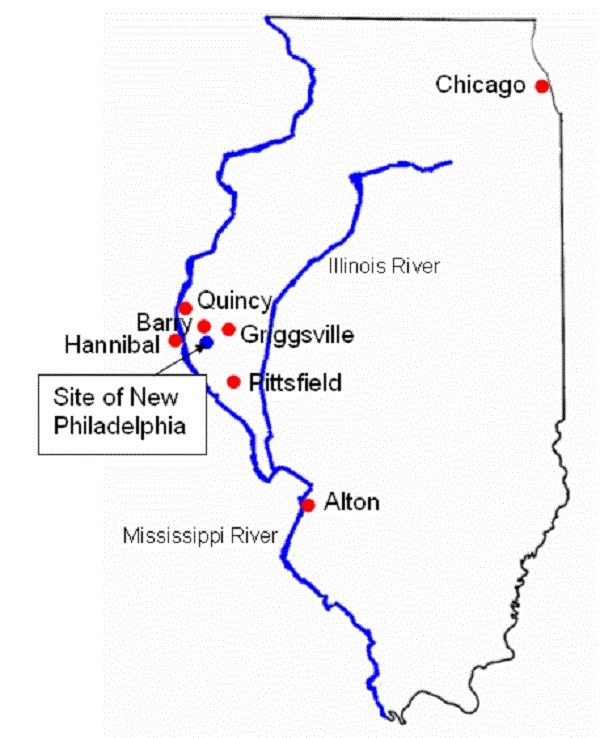
Questions for Map 1
1. Find the Mississippi and Illinois rivers. Where is New Philadelphia in relationship to these rivers?
2. Find Griggsville and Alton on the map. These two towns were the sites of racial violence in the 1830s. What does this suggest about racial attitudes in the area around New Philadelphia?
3. Philadelphia, Pennsylvania is known as the "City of Brotherly Love." Why do you think Free Frank chose that name for his new town?
4. On a classroom map, identify the states surrounding Illinois. Which of these states were slave states before the Civil War? Which were free states?
5. Do you think free African Americans would have felt safe in New Philadelphia? Why, or why not? Bear in mind that during the period before the Civil War, "slave catchers" could capture formerly enslaved people living in free states and steal or destroy the papers proving their free status. The slave catchers could then carry the freedmen off to slave states and sell them back into bondage.
Determining the Facts
Reading 1: Free Frank McWorter
The story of New Philadelphia begins with its founder, a formerly enslaved African American named Free Frank McWorter, and his quest for freedom.
Like other enslaved individuals, Frank was called only by his first name when he was born in 1777 in the foothills of South Carolina's Blue Ridge Mountains near the Pacolet River. Frank's mother Juda was a young enslaved woman from Africa and it is believed that Juda's Scotch-Irish owner, George McWhorter, was Frank's father. In 1795, while still enslaved, Frank and his owner left South Carolina for the rolling hill and cave region of Kentucky's Pennyroyal Frontier. It was here that Frank met and married Lucy, enslaved on a neighboring farm. Slave marriages were not legally recognized, but Frank and Lucy became man and wife without ceremony in 1799, a union that lasted fifty-five years.
Life on the frontier was focused on survival. That meant clearing land, building dwellings and other structures, and planting crops to transform a wilderness into productive farmland. Shortages of labor on the frontier and the determination of slave owners to make as much money as possible from their human possessions allowed some enslaved individuals to earn cash by hiring out their time to other settlers. Owners profited because they collected a portion of the earnings. Employers benefited because they paid enslaved laborers less than free laborers. Frank's earnings provided seed money toward his goal: to buy himself and his family out of bondage one by one, as he accumulated enough funds.
A resourceful man, Frank supplemented his earnings by producing saltpeter. Saltpeter was used to manufacture gunpowder, a crucial element in frontier living. It was even more in demand once the War of 1812 began. Kentucky's Pennyroyal caves were rich with crude niter, saltpeter's main component. Frank worked on his owner's farm from sun-up to sundown. He mined crude niter and processed the material into saltpeter at night and on days off.
Frank became "Free Frank" after he purchased his freedom in 1819; he had purchased his wife Lucy's freedom two years earlier. Their son, Squire, born when Lucy was free, was free from birth. Free Frank's status as a freed man entitled him to some basic rights under the United States Constitution, including the right to own property. Property ownership represented economic security and opportunity to free African Americans. It validated citizenship and strengthened their position in legal transactions. Free Frank used his hard earned money well. In addition to buying freedom, he purchased land in Kentucky.
Increased prejudice against African Americans and competition with the growing number of European-American immigrants may have been among the factors that motivated Free Frank to move away from the slave state of Kentucky. In addition, his earning power was diminished in 1829 when he traded his lucrative saltpeter production operation for his son Frank's freedom. Young Frank had run away as a fugitive slave to Canada. Through his father's resourcefulness, he returned to his family in the United States as a free man.
Aware of Free Frank's interest in moving to a free state, local physician Dr. Galen Elliott sold him a piece of land on the Military Tract in Illinois. The federal government had created this large tract, located between the Mississippi and Illinois rivers, primarily to rewarded veterans for their military service. Land ownership allowed Free Frank to circumvent Illinois' Black Code, which required formerly enslaved individuals moving to the state to post a $1,000 bond.
In 1830, after a year of preparation, Free Frank; his wife Lucy; his son Frank; and his free-born children Squire, Commodore, and Lucy Ann loaded their wagons and left Kentucky behind to begin a new life on the Illinois frontier. Three additional children and several grandchildren born into slavery remained behind. Free Frank promised that he would return to secure their freedom as soon as he accumulated enough money. The journey to Illinois was dangerous. The family risked capture by the slave catchers who were continually on the prowl and unscrupulously stole or destroyed freedom papers. Without this documentation, freedmen and women could be sold back into bondage.
Free Frank and his family saw their new land for the first time in the spring of 1831. According to maps of the time, Free Frank set up his farm at the edge of a stand of trees, near a spring and running creek in Hadley Township, Pike County, Illinois, about 20 miles from the Mississippi River.
Once a rudimentary farmstead was set up, Free Frank and his family set about planting and harvesting crops. They also joined and became active members of the local Baptist church. By their second year in Illinois, Free Frank and his family farmed about 80 acres of their land using implements and livestock brought from Kentucky. Their cash crops included oats, barley, potatoes, and flax, as well as livestock, such as cattle, horses, and hogs. Like many women on the Illinois frontier, Lucy contributed to her family's earnings by making butter and cheese, collecting honey, and raising poultry.
By 1835 Free Frank had set aside enough money to buy his son Solomon out of slavery. Securing Solomon's freedom meant a return to Kentucky and once again facing the threat of capture by slave hunters. It was a risk Free Frank undertook several times as he earned the funds to purchase additional family members. Free Frank and his family also used their money to purchase a neighboring 80-acre tract of Military Land directly from the United States Government. It was on a portion of that land that Free Frank laid out New Philadelphia in 1836.
In 1837, Free Frank petitioned the Illinois General Assembly to take the legal last name of McWorter, a variation of his former owner's surname. That technicality would protect his real estate holdings and entitle him to other legal privileges. The petition noted that Free Frank intended to devote the proceeds of his land sales to purchase freedom for family members still bound by slavery in Kentucky. Fourteen white Pike County citizens attested to Free Frank's good character.
By the time of his death in 1854, Frank McWorter had purchased freedom for all four of his seven children born in slavery, his daughter-in-law Louisa, and two enslaved grandchildren, in addition to himself and his wife Lucy. In addition, he directed his descendents to purchase the freedom of additional grandchildren and great-grandchildren after his death. All told, Frank McWorter bought the freedom of 16 enslaved individuals at a cost of $14,000, a sum equal to hundreds of thousands of dollars in today's currency. His legacy also included a bustling town whose population grew even larger after his death. Frank McWorter, along with Lucy and his children, lie buried in the black cemetery about a half mile east of the site of New Philadelphia. In addition to the townsite, Frank McWorter's gravesite also is listed in the National Register of Historic Places.
Questions for Reading 1
1. How did Frank earn the money to buy his freedom and that of his wife?
2. Why did owners allow slaves to hire out their time to other settlers?
3. Why are some of the reasons why Free Frank might have wanted to leave Kentucky?
4. What advantages did Frank gain by owning property?
5. How difficult do you think it would have been for Frank to collect $14,000 in cash on the Illinois frontier? How would you go about earning the equivalent among of money today for such an important purpose?
Reading 1 is based on Juliet E. K. Walker, Free Frank: A Black Pioneer on the Antebellum Frontier (Lexington: University of Kentucky Press, 1983; 1995 reissue edition); the Historical Landscapes of New Philadelphia, Illinois website at the University of Illinois, Urbana-Champaign; Grace Matteson, "Free Frank" McWorter and the "Ghost Town" of New Philadelphia, Pike County, Illinois (Pittsfield, IL: Pike County Historical Society, 1964); Bruce Tomlinson, "Slave Founded Pike Village," Quincy [Illinois] Herald-Whig, May 29, 1977; Tamara Browning, "Preserving a Legacy of Freedom" [Springfield, Illinois] State Journal Register, February 10, 2002; Paul A. Shackel, Terrance J. Martin, Joy D. Beasley and Tom Gwaltney, "Rediscovering New Philadelphia: Race and Racism on the Illinois Frontier," Illinois Antiquity (March 2004); Michelle Huttes, "New Philadelphia Town Site" (Pike County, Illinois) National Register of Historic Places Registration Form (Washington, DC: Department of the Interior, 2005).
Determining the Facts
Reading 2: New Philadelphia
It was in 1836, during a time of high racial tension in the United States, that Free Frank mapped out a town on 42 acres of his Military Tract land. He laid out 144 lots, each measuring 60 feet by 120 feet. He called his town Philadelphia and sold lots to black and white settlers alike. He farmed and made his home on land adjacent to the town. New Philadelphia, as it came to be known, offered settlers of both European and African descent fertile, affordable land, and economic opportunities on the frontier. Although lots in the town were reasonably priced, few African Americans could comply with Illinois' stringent settlement laws. Nevertheless, the proportion of black individuals living in New Philadelphia was high compared to the state as a whole in 1850. Those black individuals who did live in the town found not only economic opportunities, but a sense of community and security.
New Philadelphia seemed primed for success. An abundant supply of trees stood ready to be crafted into homes, furniture, fences, and wagons, and used for fuel. In 1839, a grocery store opened its doors. Construction of the Illinois and Michigan Canal connecting the Great Lakes to the nearby Mississippi River promised access to distant markets. Stage coaches stopped at New Philadelphia and people from miles away brought business to local trades-people when they collected their mail from New Philadelphia's post office. A road linking the town to the commercial hub of Quincy was planned. Land speculators with no intention of living in the town bought most of the lots hoping to make a profit reselling them to settlers as the town grew and the demand for land increased.
The state's decision in 1840 to re-route a major road linking the Illinois River byway of Griggsville to the Mississippi River through Kinderhook made travel to and from New Philadelphia more difficult and may have slowed the town's growth for a time. As a black town owner, Frank McWorter may not have had enough political influence to garner support among state and local legislators to route the road directly through his town.
LeGrange Wilson, who carried mail to the town on his route from Griggsville to Kinderhook, noted only three homes in the village in the 1840s. But by 1850 at least 58 people lived in the town's 11 households. Most residents came from Illinois cities. Occupations were typical of other frontier villages and included farmers, shoemakers, a cabinet maker, a wheelwright, a Baptist preacher, a laborer, and a merchant. While African-American residents represented only 38 percent of the population of the town, this was far above the proportion of African Americans living in the state. Illinois reported only 5,436 black residents in the state, 0.6 percent of the total population of 851,470 in 1850.
After Frank McWorter's death in 1854, New Philadelphia continued to attract new settlers. The 1860 federal census reported 114 people living in the town. The community's 21 residents categorized as black and mulatto in the 1860 census accounted for 18% of the town's total population. The census defined mulatto as any person with at least one-quarter black ancestry. Although Illinois was officially a free state, voting records, newspaper articles, and the state's Black Codes reflected many residents' racial prejudice. First enacted in 1819 to discourage settlement and competition for jobs by free blacks, the Illinois Black Codes were the most stringent in the region by 1848. The Black Codes required a certificate of freedom from formerly enslaved individuals already living in the state and those intending to immigrate from elsewhere. Individuals without registered certificates risked arrest. A $1,000 bond was required of formerly enslaved individuals attempting to move into the state. African Americans were restricted from assembling in groups of three or more. This law was sometimes applied to entire communities when they grew too large.
Some local descendants claim that New Philadelphia's citizens lived together harmoniously. However, during this racially tense time, turbulence flared in Griggsville, only 13 miles east of New Philadelphia, after some citizens signed a petition to abolish slavery in the nation's capital and to deny the admission of Texas into the Union as a slave state in 1838. Only 50 miles away, Alton newspaper owner and abolitionist Elijah Lovejoy was killed in 1837 while trying to protect his press. It was also during this time that Illinois became a link in the Underground Railroad, a cooperative system of antislavery people that secretly helped enslaved persons escape to northern states or Canada. Oral histories from local residents report that the Underground Railroad was active in the area. New Philadelphia's location at a major crossroad could have made it a prime stop on the escape route for fugitive slaves.
New Philadelphia's population peaked in 1865 with 160 individuals. State census takers recorded that 30 percent of the townsfolk were black, nearly double the number reported on the federal census just five years earlier. The large influx of African Americans may be attributed to the migration of formerly enslaved individuals moving away from the South after the Civil War. Out of the way agricultural communities like New Philadelphia were an attractive alternative for African Americans seeking to avoid the racial hostilities of large urban centers or the confinement of remote farm settings.
By 1853 railroads had begun to displace the stagecoaches, steamboats, and freight wagons that had moved people and goods across the state. In that year, influential local businessmen and farmers formed the Pike County Rail Road Company to map out a route for a railroad linking Hannibal, Missouri, to Naples, Illinois. Communities and towns along the train's route flourished, while settlements bypassed by the railroad withered. Corruption, greed, political influence, and special incentives often influenced the selection of station stops. New Philadelphia had no spokesperson to represent the town's interest on the railroad's board of directors. Although it is not documented, many believe racial discrimination influenced the board's decision to bypass the town.
When the railroad was finally built in 1869, the line traveled due west from a point on the Illinois River to the white town of New Salem, and then arched northward around New Philadelphia. Just past New Philadelphia, the line turned back to the south, returning to its east-to-west trajectory and connecting with Barry, another largely white community. Railroads usually bypassed towns because there were large topographic features that had to be avoided or because other towns were more successful in lobbying to be made station stops. The latter of these potential explanations seems to be the case for New Philadelphia. As the railroad steamed around the town, it took business, trade, and quick access to markets with it.
While towns with railroad access-like Quincy and Barry in Illinois and Hannibal, Missouri-grew, the federal census of 1880 recorded only 87 people residing in New Philadelphia. People moved away in search of jobs closer to market centers. A few townsfolk stayed until the 1940s, but by 1885 about one-third of the land was in agricultural use.
New Philadelphia disappeared as plows turned over the soil and buried any material remains left behind. But the recollections of former townsfolk and their descendants kept the story of Free Frank McWorter's town alive in a variety of publications. These include Grace Matteson's Free Frank McWorter and the Ghost Town of New Philadelphia, Pike County, Illinois, published in 1964; Helen McWorter Simpson's book, Makers of History, published in 1981; Dr. Juliet Walker's 1983 book, Free Frank: A Black Pioneer on the Antebellum Frontier; and Lorraine Burdick's 1992 publication, New Philadelphia: Where I Lived. In 1996, local residents and community leaders in Barry and Griggsville formed the New Philadelphia Association to preserve the site of the once thriving integrated community. Descendants of the town and area residents are now members of the association.
Questions for Reading 2
1. Why do you think Illinois enacted Black Codes? What was their purpose?
2. What was the racial atmosphere of the area surrounding New Philadelphia?
3. Why do you think Free Frank sold land in the town to both white and black settlers?
4. Why do you think European American settlers were attracted to New Philadelphia? Why do you think African-American settlers were attracted to New Philadelphia?
5. How did transportation and transportation corridors contribute to the settlement and prosperity of New Philadelphia? How did they harm the community?
6. Why do you think New Philadelphia ceased to exist?
Reading 2 was based on documents and maps prepared for the Center for Heritage Resource Studies at the University of Maryland, especially Archaeology Report, October 3 2005, historic maps of New Philadelphia, and population census schedules for Pike County, Illinois; William D. Walters, Jr., "Time and Town Square," Bulletin of the Illinois Geographical Society, XXII, No. 2 (Fall, 1980), 18-25; Robert Mazrim, Now Quite Out of Society: Archaeology and Frontier Illinois (Urbana: Illinois Transportation Archaeological Research Program, Dept. of Anthropology, University of Illinois at Urbana-Champaign, 2002); Juliet E. K. Walker, Free Frank: A Black Pioneer on the Antebellum Frontier (Lexington: University of Kentucky Press, 1983; 1995 reissue edition; Sundiata Keita Cha-Jua, America's First Black Town: Brooklyn, Illinois 1830-1915 (Urbana: University of Illinois Press, 2000); Michelle Huttes, "New Philadelphia Town Site" (Pike County, Illinois) National Register of Historic Places Registration Form (Washington, DC: Department of the Interior, 2005); and Lorraine Burdick, New Philadelphia: Where I Lived (self-published, 1992).
Determining the Facts
Document 1 - Selection from 1850 Population Census Schedule for Hadley Township, Pike County, Illinois
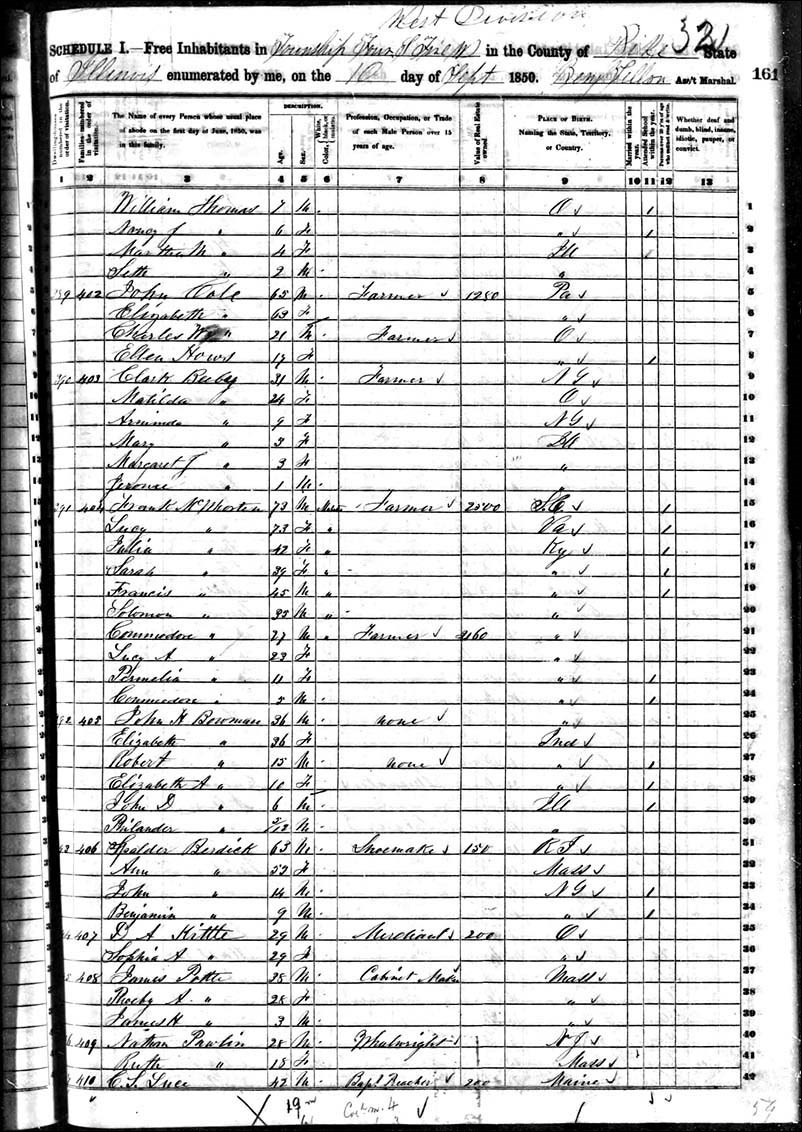
The U. S. Constitution requires the population of the country to be counted every ten years. In the 1800s and into the 1900s, census enumerators visited every property, recording the name, age, marital status, place of origin, race, occupation and value of real estate for each person they found. The census administrators created racial categories, such as white, black, and mulatto, with which each individual was to be classified by the enumerators. Census reports were used to determine the number of Congressmen who would represent the state in the House of Representatives and to set up tax districts. This document is a page from the 1850 United States federal census listing Frank McWorter and all the people living in the McWorter household the day the census was recorded. Note how the census enumerator spelled McWorter."
The census records do not identify exactly where people lived. Because we know that Frank McWorter lived directly outside New Philadelphia, it is likely that the people listed after his family lived in the town. Information found in land deeds, maps, and historical reports also helped define who lived there.
Questions for Document 1
1. Why do you think government officials required census enumerators to identify every citizen in the country by name?
2. According to this page, where was Frank McWorter born? How much real estate did he own?
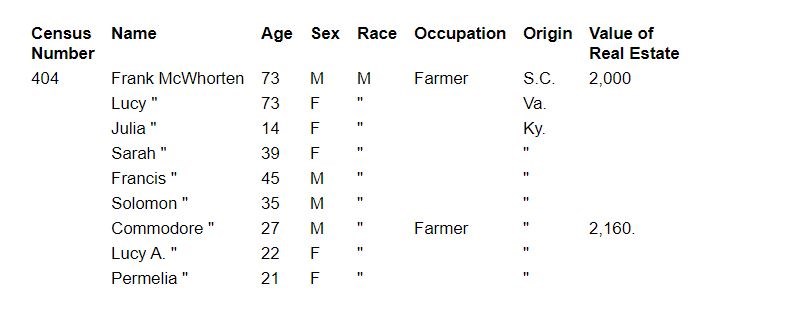
Determining the Facts
Reading 3: Archeology at the New Philadelphia Site
Archeologists and historians are telling the story of New Philadelphia through historical documents, oral histories from town descendants and community members, and artifacts recovered at the site. The first extensive archeological investigation of New Philadelphia took place in 2002 and 2003. In 2004 the National Science Foundation's Research Experience for Undergraduates funded a three year program to study the site. Researchers were seeking a better understanding of the social and physical development of the town from its founding to its demise. By 2006 archeological excavations had exposed building foundations, underground structures, and many artifacts.
No original buildings stand on the site of New Philadelphia. No photographs or drawings of the town are known to exist, and no one knows for certain when or where the first structures were built after the town's founding in 1836. Oral histories and written recollections tell us that the homes were typical of frontier towns. They were one or one and a half story log cabins or wood frame dwellings built over shallow cellar pits with outlying structures to house livestock. One building was a two story structure. Among the sites archeologists believe to be related to the town's early settlement were cellar pits, a substantial building foundation, and some wells. The wells remain as deep circular holes in the ground. They were eventually filled with soil and household trash, including animal bones, ceramics, and glass manufactured in the 1850s. That filling-in indicates the wells had been constructed prior to 1850 and were used as trash repositories after they were abandoned.
Archeological finds tell us about the day-to-day lives of New Philadelphia's townsfolk. For example, the discovery of an ink bottle and decorated glass flasks manufactured in the Ohio Valley, along with English ceramics, confirms that New Philadelphia's merchants traded with market centers such as St. Louis, Missouri to make goods produced in distant places available to residents of the town. The large fragments of canning jars, along with several intact milk glass lid liners attached to metal sealing caps, found at various locations tell us that residents preserved food, such as fruit and vegetables probably grown in their gardens. Stems and bowls of clay tobacco pipes popular in the 19th century and a portion of a mouth harmonica show how some adults spent their free time.
Analysis of animal remains can reveal information not only about diet, but also about the backgrounds of the town's inhabitants and the food preferences they brought with them when they came to New Philadelphia. For example, the fish, chicken, pig, squirrel, rabbit, opossum, and duck bones found at one household are indicative of an "Upland South" diet. This suggests that the people who lived there might have come from areas in Kentucky, Tennessee, and the Carolinas where they traditionally had eaten these foods. Deed and census records tend to confirm that many of New Philadelphia's residents did, in fact, come from that region.
Archeology also provides a glimpse into the activities of the town's children. Various types of marbles; a miniature pewter teapot, spoon, and pitcher; several porcelain doll parts; and a portion of a metal diesel locomotive found at the town site are toys that most likely belonged to the town's children.
Mancala is a mathematical game that made its way from Africa to the Americas via the slave trade. At New Philadelphia archeologists found gaming pieces they think may be related to this ancient game. There are many variations of the game, but in Africa players placed counters, which might be pebbles, seeds, or beans, into a series of small depressions carved into wooden playing boards or dug into the ground. The purpose of the game was to capture counters and the player who succeeded in taking the most pieces from his opponents won the game. Smoothed, unglazed ceramic and glass fragments about half an inch in diameter found throughout the New Philadelphia site may be mancala gaming pieces, possibly reflecting the survival of African cultural traditions among the town's African-American residents.
Census records show that New Philadelphia's population declined significantly after the Hannibal-Naples Railroad bypassed the town in 1869, and that many of the townsfolk moved away in search of jobs and economic opportunities elsewhere. The recovery of a small badge inscribed "ILLS. STATE FAIR 1903" and a quantity of wire nails manufactured after 1880 seems to confirm reports from descendants and local residents that a few people continued to live in New Philadelphia into the early decades of the 1900s.
By the 1940s, none of the original buildings remained above ground. The land was used for farming and pasture for livestock for many years, but now prairie grass and wildflowers cover the fields. By telling the story of New Philadelphia, archeology is giving a voice to people neglected by American history and painting a more accurate portrait of our nation's past. New Philadelphia was listed in the National Register of Historic Places in August 2005 in recognition of its archeological significance and its place in our country's history.
Questions for Reading 3
1. What kinds of information have the archeologists found at New Philadelphia?
2. Where did the mancala game originate? What do you think finding game pieces possibly used in the playing of this game suggests about the people who lived in New Philadelphia?
3. Which of the following do you think is important to study when telling the story of a place like New Philadelphia: historical records, oral histories, artifacts? Why?
4. Review Reading 3 and make a list of the things that archeologists have learned about life in New Philadelphia. How much of this information could have been found in written documents? How much in recent oral histories? How important do you think information like this is in telling the story of New Philadelphia?
Visual Evidence
Drawing 1 - Layout of New Philadelphia in 1836
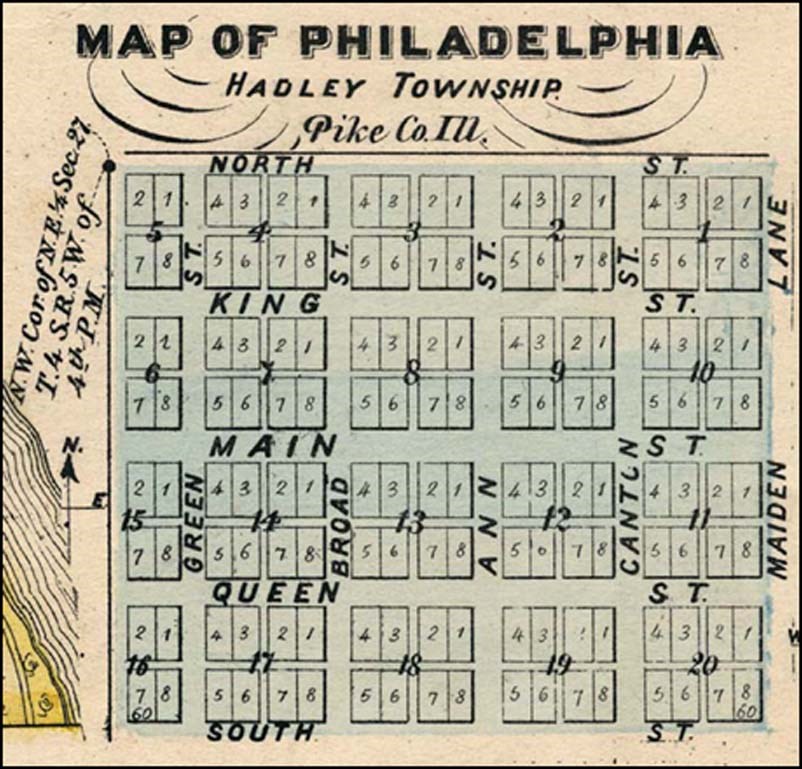
When Free Frank laid out New Philadelphia in 1836, he divided it into 144 lots on 20 city blocks. Each lot measured 60 feet by 120 feet. Free Frank's homestead was located just north of the town site.
Questions for Photo 1
1. When Free Frank laid out the town, he made Broad Way and Main Street 80 feet wide; other streets were 60 feet wide. Where do you think the main intersection in the town would have been?
2. Why do you think Free Frank McWorter made the two main streets so wide?
3. If you were planning on building a store or other commercial building, where do you think you would put it? Why?
4. Why do you think a narrow ribbon of open space divided each block into quarters? What purpose would that open space serve?
Visual Evidence
Photo 1 - Aerial view of New Philadelphia, 2005
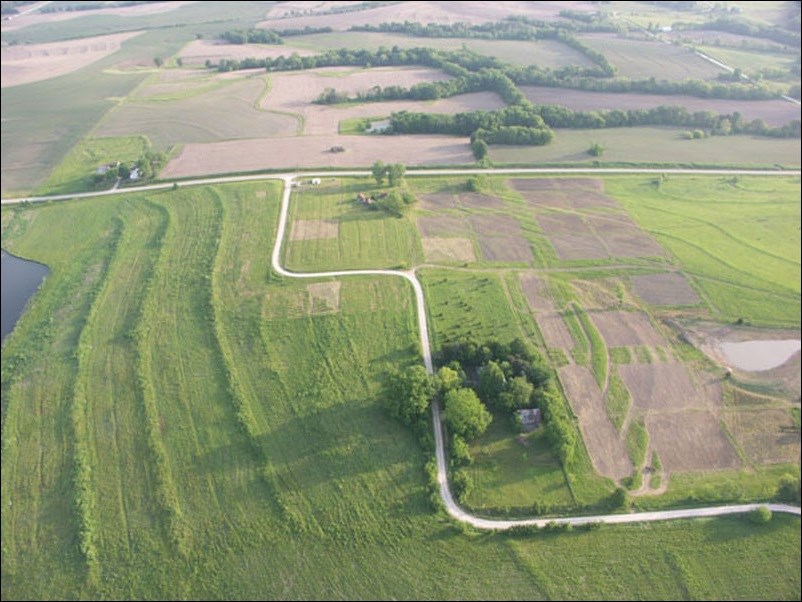
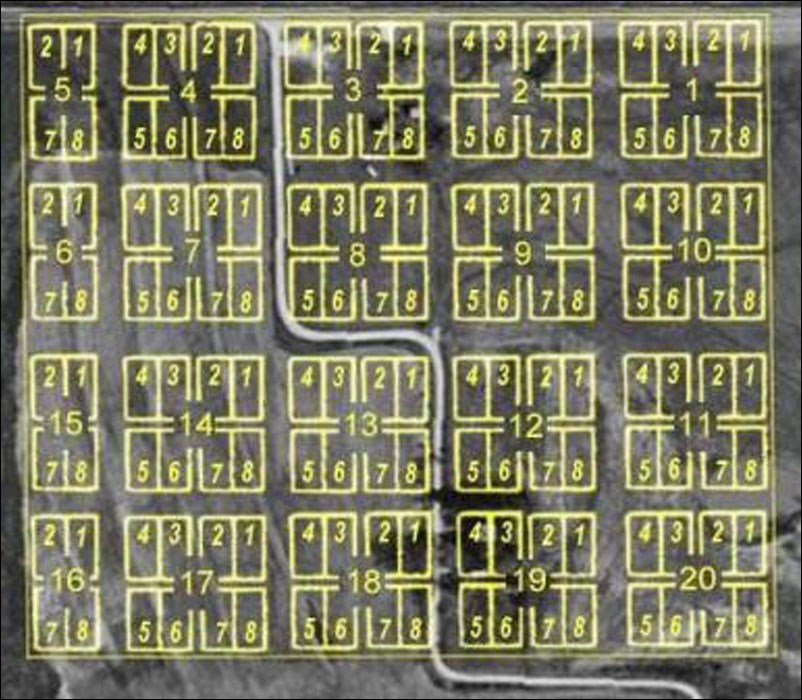
Questions for Photos 1 and 2
1. Describe what you see in each of these photos. How are they alike? How are they different?
2. The white line in both photos represents a recently resurfaced road. Why do you think it makes two sharp turns in the middle of an open field? Does that suggest anything about the age of the road?
Visual Evidence
Photo 3 - Artifact 1
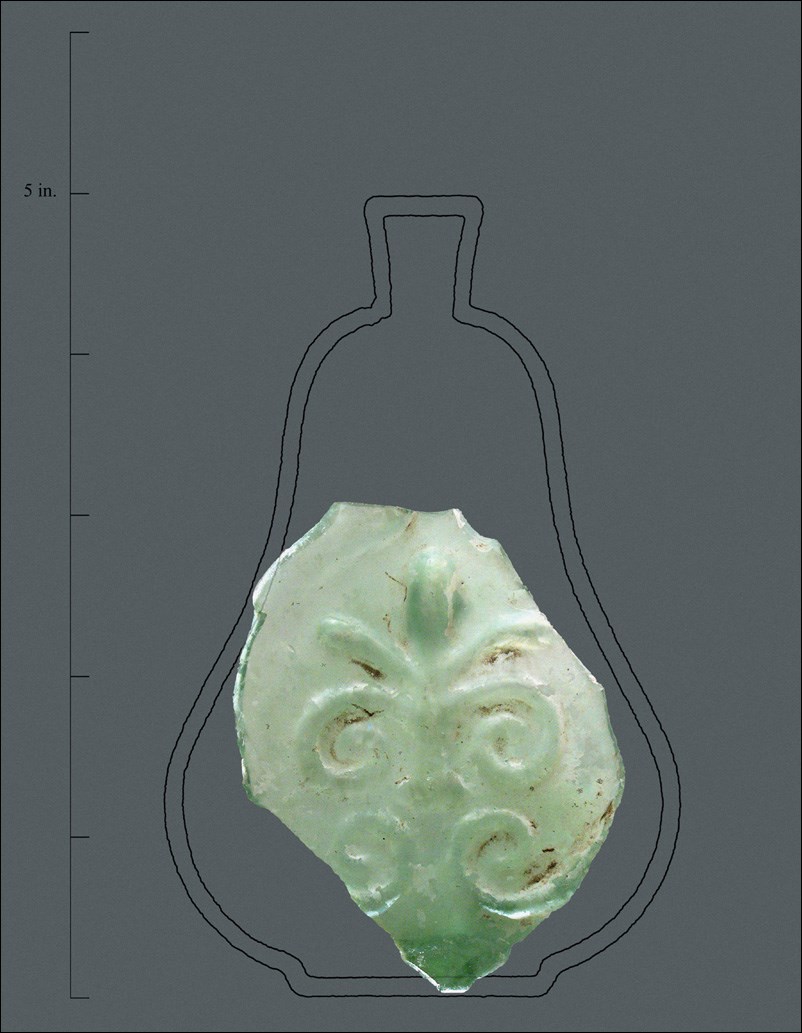
(Photo by Chris Valvanno)
Questions for Photo 3
1. Archeologists recovered this fragment of green glass, measuring approximately 3 by 2 inches, in their excavations. What do you think it might have been part of? How would you go about finding out?
2. The archeologists at New Philadelphia consulted an archeological reference work and discovered that this fragment was part of a small bottle or flask manufactured in Louisville, Kentucky some time between 1855 and 1873. How do you think the bottle might have gotten to New Philadelphia?
3. Why is it important to know when the bottle was manufactured? Refer back to Reading 3, if necessary.
Visual Evidence
Photo 4 - Artifact 2
![Piece of metal with words "US State Fair, 1903". An archaeological artifact. (Courtesy [Springfield, Illinois] State Journal Register, Photographer: Shannon Kirshner) Piece of metal with words "US State Fair, 1903". An archaeological artifact. (Courtesy [Springfield, Illinois] State Journal Register, Photographer: Shannon Kirshner)](/articles/images/130photo4ch.jpg?maxwidth=1300&autorotate=false)
(Courtesy [Springfield, Illinois] State Journal Register, Photographer: Shannon Kirshner)
Questions for Photos 4
1. This artifact measures approximately 2 inches by ½ inch. It is made of brass. The inscription reads "ILLS. STATE FAIR 1903." What do you think it might have been originally?
2. The archeologists who found it in the excavations at the New Philadelphia weren't sure either, but they eventually discovered that it was part of a pin that was given to veterans of the Civil War or the Spanish American War by the Grand Army of the Republic, an organization of Civil War veterans. The veterans were admitted free on Old Soldiers' Day at the Illinois State Fair in 1903. Another pin like this, inscribed with the words "SAN FRANCISCO," was found in more recent investigations. What do you think these artifacts suggest about the people who lived in New Philadelphia?
3. Why is the date of this souvenir pin important? Refer to Reading 3, if necessary.
Visual Evidence
Photo 5 - Archeological excavation at New Philadelphia
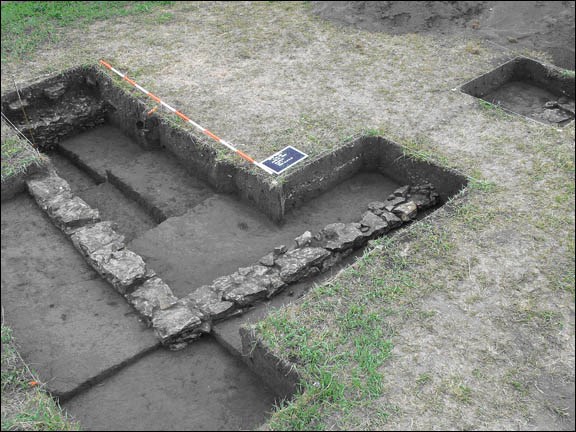
Questions for Photo 5
1. This photo shows a pit excavated during the archeological investigations. The rows of rocks represent the foundation of a house or other structure. How do you think you would go about finding out what kind of structure it was originally?
2. The foundation was found in Lot 7 of Block 3. Referring back to Drawing 1, how does this location relate to the main streets of town?
3. Artifacts recovered in this location include pieces of dishes used for food. How do you think this information might help in identifying what kind of building was located here?
Putting It All Together
In this lesson, students learn about Free Frank McWorter, the brave and resourceful formerly enslaved man who created New Philadelphia, about the town, and about what archeology has learned about its residents. The following activities will help them apply what they have learned.
Activity 1: Personal Narratives
Ask students to read narratives of people who purchased themselves and family members out of slavery, as Free Frank did, on the National Humanities Center’s resource sheet, “On Buying One’s Freedom: Selections from 18th- & 19th-Century Slave Narratives.” Students may read longer versions of the passages by Venture Smith and Elizabeth Keckley at the National Humanities Center's page “Buying Freedom.” Encourage students to use an online inflation calculator to better understand the prices the narratives' references to money. The amounts adjusted for inflation will likely be far more than students expect.
Then discuss as a class: What dangers did the authors of these narratives face in purchasing freedom for themselves and other family members? How do you think they decided which whose freedom to purchase first?
Activity 2: Telling the Story of New Philadelphia
Historic places like New Philadelphia, where there are no standing structures, still can tell stories about the past. Divide the class into three groups and ask them to prepare for a discussion of the best way to use the information that has been collected about New Philadelphia. Have each group research a place that represents one of the following scenarios:
1) An archeological site that has been left largely unchanged, such as Jamestown National Historic Site, Virginia, or Fort Frederica National Monument, Georgia.
2) A place where original historic buildings and structures have been reconstructed, such as Old Fort Harrod State Park in Kentucky, Fort Vancouver National Historic Site, Washington, or Fort Osage National Historic Site in Sibley, Missouri.
3) A place made up of old buildings that have been moved to the site from their original locations, like Old Sturbridge Village, Massachusetts, or Heritage Hill Living History Museum in Green Bay, Wisconsin.
Information on all of these sites is available on the web. Each group should analyze what information is available on New Philadelphia and develop a written recommendation for what they think is the most appropriate scenario to help visitors understand what happened at New Philadelphia historically. The recommendations should address such questions as 1) the amount of information that would be needed to ensure historical and architectural accuracy, 2) the possible loss of original material or data, 3) the cost, and 4) the ability of visitors to understand what they are seeing.
Ask representatives from each group to report to the whole class and hold a discussion about the relative merits of each scenario. Finally, ask the whole class to vote on how they think the story of New Philadelphia can best be told.
Activity 3: Discriminatory Legislation in the Local Community
Many people know about the Jim Crow laws that were used in the 20th century to enforce legal segregation of African Americans in the South. Fewer people know about the Black Codes that many states, both North and South, enacted before the Civil War to restrict the activities of free African Americans. Divide the class into two groups. Ask the first group to investigate whether any Black Codes were enacted in their community and the second to study any local Jim Crow laws. Ask them to find the answers to such questions as: When were these laws enacted? Whom did they apply to? What were their provisions and how did they affect the lives of African Americans? What were they intended to achieve? How successful were they in accomplishing what they were supposed to do? Ask each group to make a presentation of their findings to the class. If there are older members of the community who remember the days of segregation, they might be willing to visit the class and tell them what it was like.
If no Black Codes or Jim Crow laws ever applied in the community, have the class investigate whether there were other informal restrictions on local African Americans or on members of other minority groups, such as Hispanic- or Asian-Americans or American Indians.
Additional Resources
By studying New Philadelphia: A Multiracial Town on the Illinois Frontier, students will learn about Free Frank McWorter and how archeology can help tell the story of the interracial town he founded in the years before the Civil War. Those interested in leaning more will find a number of useful sites on the Internet.
Center for Heritage Resource Studies, University of Maryland
A link to New Philadelphia on the Center for Heritage Resource Studies website provides information on the archeology project at New Philadelphia, the history of the town, research reports, census, tax and deed records, oral histories, and other material.
Free Frank New Philadelphia Historic Preservation Foundation
The website for the Free Frank New Philadelphia Historic Preservation Foundation provides information about the foundation's activities, its plans for restoration of the historic town, and its petition campaign for a United States postage stamp honoring Free Frank.
McWorter Family
The McWorter Family website contains a variety of documents about the descendants of Free Frank McWorter.
The New Philadelphia Association
This website contains information about an association founded by residents of communities near New Philadelphia to preserve the site in honor of Free Frank McWorter. It contains useful background information, links to other New Philadelphia sites, and membership information.
Time Team America's "New Philadelphia" at PBS.org
The Time Team America TV show about North American archeology aired an episode about New Philadelphia. Free video clips from the episode can be found at PBS.org. They feature the work of archeologists, including student archeologists, at the historic site, the lives of the people who lived there, and the site's significance as a National Historic Landmark.
For further reading
Juliet E. K. Walker is Free Frank McWorter's great great granddaughter. Her book, Free Frank: A Black Pioneer on the Antebellum Frontier (Lexington: University of Kentucky Press, 1983; 11305 reissue edition), contains detailed information about Free Frank McWorter and about the town of New Philadelphia.
Read Sundiata Keita Cha-Jua's book, America's First Black Town: Brooklyn, Illinois 1830-1915 (Urbana: University of Illinois Press, 2000), to learn more about the history of America's all-black towns and how they provided economic and social opportunities for African-Americans.
Tags
- new philadelphia national historic site
- african american history
- archeology
- archaeology
- migration and immigration
- civil rights
- federal
- mid 19th century
- slavery
- teaching with historic places
- twhp
- illinois
- illinois history
- new philadelphia
- archaeological site
- emancipation
- midwest
- late 19th century
- gilded age
- progressive era
- african american sites
- twhplp
- cwr aah
- ga aah
